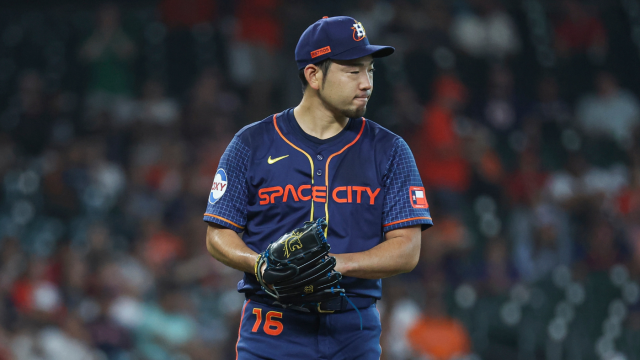The Los Angeles Angels continued their busy winter on Monday, reportedly agreeing to a three-year pact worth $63 million with left-handed starter Yusei Kikuchi. The Angels came into the week having added outfielder/designated hitter Jorge Soler, catcher Travis d'Arnaud, infielders Kevin Newman and Scott Kingery, and pitcher Kyle Hendricks to their roster over the offseason's first month. Clearly general manager Perry Minasian believes his team can mimic the Kansas City Royals' arc, from finishing in last place to earning a postseason berth in a year's time behind a strong winter.
Kikuchi, 33, is coming off a season split between the Toronto Blue Jays and the Houston Astros. Overall, he amassed a 4.05 ERA (99 ERA+) and a 4.68 strikeout-to-walk ratio. His contributions were worth an estimated 1.4 Wins Above Replacement, according to Baseball Reference's calculations. Notably, Kikuchi pitched much better after a midseason trade to the Astros: in his final 10 starts, he compiled a 2.70 ERA (147 ERA+) and a 5.43 strikeout-to-walk ratio across 60 innings. Those marks would've represented the highest of his career if they had taken place over a full season.
Just what did Kikuchi change after the trade that convinced the Angels to commit to him beyond his 36th birthday? Here are three modifications worth knowing about.
1. Hiding the heater
One of the most obvious tweaks a pitcher can make nowadays is reducing their fastball usage. This is the era of the secondary pitch, with the league as a whole throwing just 47.8% fastballs and sinkers in 2024, as opposed to 57% a decade ago.
Sure enough, Kikuchi did just that after the trade: he reduced his fastball usage from 49.6% to 41.8%. The move wasn't just in response to the leaguewide trend, either.
Kikuchi had surrendered a .297 average and a .516 slugging percentage against his heater while with the Blue Jays; limiting the pitch's exposure after the deal allowed him to improve those metrics the rest of the way, with batters posting a .225 average and a .483 slugging percentage against the heater over his final 10 starts with the Astros.
2. Leaning in to what works
Limiting the fastball wasn't Kikuchi's only pitch-mix tweak. He also embraced the modern thinking of throwing your best pitch as often as you can. Back when the Astros acquired him, we wrote the following sentence: "Surely Kikuchi would benefit from reducing his curveball usage in favor of throwing more sliders and changeups."
Score one for us because the Astros did indeed have Kikuchi all but shelve his curveball (22.7% usage to 9.5%) while increasing his slider and changeup usage. Kikuchi's slider was the biggest benefactor of the other alterations he made to his repertoire. It went from representing 16.9% of his pitch selection to 37.1% -- or more than doubling.
It only makes sense that some pitches generate worse results the more they're used. Batters are quick to learn and adjust, after all. Even so, Kikuchi's slider remained a highly effective pitch. In fact, he held opponents to a .172/.245/.212 slash line against it with the Astros, all the while generating 29.2% swinging strikes -- or, roughly the same whiff rate he produced on the pitch during his time with the Blue Jays (30.2%).
3. Change in location
There was one other difference between how Kikuchi pitched with the Blue Jays and how he operated with the Astros: his location.
Whereas Kikuchi was more willing to work to the inside corner with Toronto, he changed his philosophy after the trade. To wit, he went from locating 55.9% of his pitches to the outer half to placing 67.4% of his pitches out there. Predictably, Kikuchi's shift was backed up by his results. On the year, he surrendered a .591 OPS on pitches located on the outer half of the plate, as opposed to a .791 OPS on the inner half.
Of course, it's to be seen if Kikuchi can sustain these gains heading forward. As we noted above, batters are more than capable of making the necessary adjustments given a long enough timeline. Kikuchi, meanwhile, has more often than not deserved his reputation for underperforming relative to the quality of his arsenal.
How, precisely, Kikuchi fares as batters update their priors will go a long way in determining if the Angels' desires of becoming the new Royals ever stand a chance of being realized.

